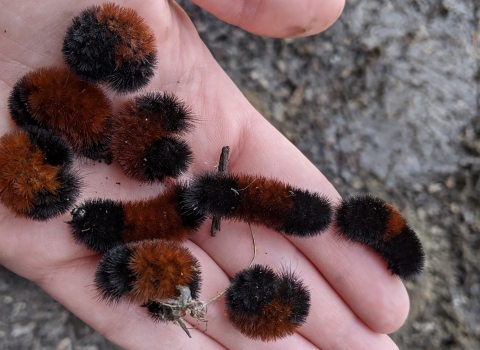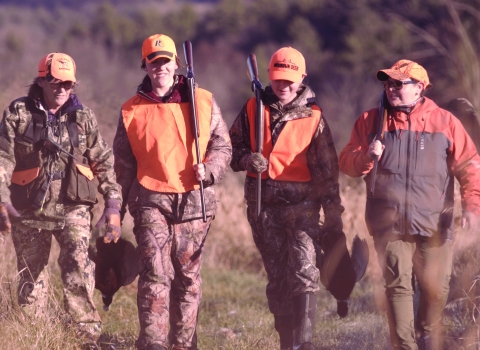Q: What is the Miami Tiger Beetle and where does it occur?
A: The tiny iridescent green Miami tiger beetle is one of the smallest tiger beetles in the U.S. and is only found in the imperiled pine rocklands ecosystem in Miami-Dade County, Florida.
Q: What are the main threats to the Miami tiger beetle?
A: The major threats facing the Miami tiger beetle are habitat loss and degradation. An estimated 98% of the historical pine rocklands within Miami-Dade County outside of Everglades National Park is gone. This habitat loss is expected to continue as a result of inadequate habitat management, development, encroaching vegetation, and continued effects of climate change climate change
Climate change includes both global warming driven by human-induced emissions of greenhouse gases and the resulting large-scale shifts in weather patterns. Though there have been previous periods of climatic change, since the mid-20th century humans have had an unprecedented impact on Earth's climate system and caused change on a global scale.
Learn more about climate change . This species' small population size and restricted range add to the severity of these threats.
Q: What action is the U.S. Fish and Wildlife Service taking?
A: The Service is designating approximately 1,869 acres as critical habitat in Miami-Dade County, Florida, for the endangered Miami tiger beetle (Cicindelidia floridana).
Q: How does the Endangered Species Act define critical habitat?
A: The Endangered Species Act defines critical habitat as the specific geographic areas that contain features essential to the conservation of an endangered or threatened species that may require special management and protection. Critical habitat may also include areas that are not currently occupied by the species but will be needed for its recovery.
Q: How does the Service determine what areas to designate as critical habitat?
A: Within areas occupied by the species, biologists consider physical or biological features needed for life processes. These include:
Space for individual and population growth and normal behavior.
Cover or shelter.
Food, water, air, light, minerals, or other nutritional or physiological requirements.
Sites for breeding and rearing offspring.
Habitats that are protected from disturbances or represent a species' historical, geographical, and ecological distributions.
After considering occupied areas, biologists consider unoccupied areas that may be essential for the conservation of the species.
Q: What are the details of the critical habitat for the Miami tiger beetle?
A: The critical habitat designated for the Miami tiger beetle includes 1,464 acres of occupied habitat and 405 acres of unoccupied habitat. The Service deemed it necessary to designate unoccupied areas to protect the remaining two small, isolated populations from encroaching habitat loss. The unoccupied units are within the tiger beetle’s historical range, contain suitable habitat, and the physical and biological features essential to the conservation of this species.
Most of the critical habitat designated for the Miami tiger beetle is under Federal (26%), state (12%), and county (60%) ownership. Approximately 71% of the designated critical habitat overlaps lands already designated as Federal critical habitat for the following species: Carter’s small-flowered flax (Linum carteri var. carteri), the Florida brickell-bush (Brickellia mosieri), Bartram’s scrub-hairstreak butterfly (Strymon acis bartrami), and the Florida leafwing butterfly (Anaea troglodyta floridalis). Find the critical habitat here.
Q: What is the background for this rule?
A: The Service listed the Miami tiger beetle as an endangered species under the ESA in October 2016. In September 2021, the Service published a proposed rule to designate critical habitat, extended the comment period to 45 days, and held a public hearing in December 2021. The final designation was developed from the additional comments and information from the comment period and public hearing.
Q: What is the draft economic analysis on this proposed action and why was it done? What did it find?
A: Draft economic analyses are created to analyze the economic impacts of a proposed critical habitat designation. It found that the economic cost of implementing the rule will be limited to additional administrative effort in considering adverse modification of the Miami tiger beetle habitat during ESA Section 7 Section 7
Section 7 Consultation
The Endangered Species Act (ESA) directs all Federal agencies to work to conserve endangered and threatened species and to use their authorities to further the purposes of the Act. Section 7 of the Act, called "Interagency Cooperation," is the mechanism by which Federal agencies ensure the actions they take, including those they fund or authorize, do not jeopardize the existence of any listed species.
Learn more about Section 7 consultations. The proposed units are largely occupied by other federally listed species like Carter’s small-flowered flax, Florida brickell bush, Bartram’s scrub hairstreak butterfly, and Florida leafwing butterfly. Conservation measures to avoid or minimize impacts on the Miami tiger beetle habitat will overlap existing protections and efforts for these already listed pine rockland species. As such, they are not expected to trigger additional requirements under state or local regulations.
Q: Where do I find the rule and supporting documents?
A: This final rule is available at https://www.regulations.gov. Comments and materials we received, supporting documentation used in preparing this rule, and the economic analysis are available for public inspection at https://www.regulations.gov at Docket No. FWS-R4-ES-2021-0053.





